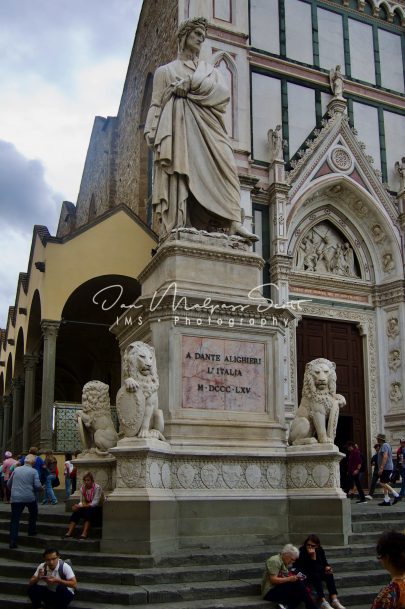![]()
Statue of Dante Alighieri, Florence, Italy
The Statue of Dante Alighieri (Monumento a Dante Alighieri) is a monument of Dante Alighieri. It is located in Piazza Santa Croce, next to Basilica of Santa Croce, Florence, Italy. It was built in 1865 by Italian sculptor Enrico Pazzi.
History
In the early 1850s, a project for a statue of Dante for a piazza in Ravenna was declined. Pazzi subsisted on small private projects for tomb monuments and house decorations. He completed for Dupre a commission for a nativity scene, destined for the Signora Bianchi of Siena, however, had difficulty getting paid.
In the 1857-59, a move was made to complete the Dante statue, but now for Florence. The patriotic Pazzi recalls an unfortunate episode when the Prince Leopold, Count of Syracuse (brother of the King of Naples) visited the studio accompanied by the interior minister of the Grand Duke, Leopold II. The visiting Prince inquired why Dante was surrounded by beasts. Pazzi indicated the lions were the Marzocchi, long a symbol of Medici Florence. However, when asked why the eagle did not have a double head, the symbol of the Habsburg dynasty, Pazzi impertinently replied that this was a Roman Eagle, arising from the ashes of the fallen Roman Empire. With this, the retinue left. Pazzi’s statue would take nearly half a decade to rise in the piazza.
The statue was erected in 1865 to celebrate the 600 year anniversary of the birth of the poet Dante. The pedestal was designed by Luigi del Sarto. The creation of a statue of a famous Florentine by a sculptor from Ravenna caused some rumblings. Florence and Ravenna for years had disputed who was to hold the remains of Dante: his native city or the city of his exile. The church of Santa Croce which stands on the same piazza of this statue has an elaborate but empty tomb monument to Dante.
The pedestal has four Marzocco lions with shields holding the names of minor Dante works and the symbols of various Italian cities who contributed to the cost of the sculpture.
The statue initially placed in the center of the Piazza was later moved to in front of the flank of the façade of the Basilica.


